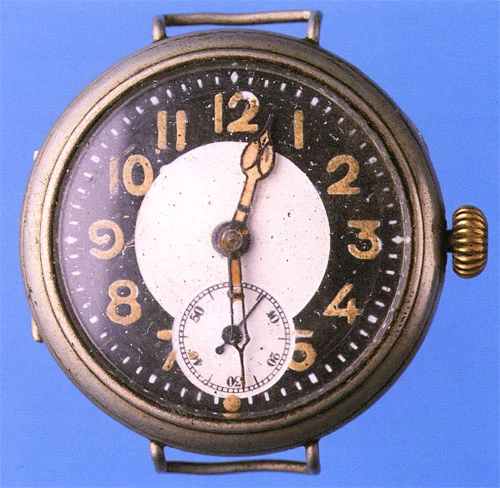Radioactive Watches at Amgueddfa Cymru
A number of items in the collection of watches at Amgueddfa Cymru 'glow-in-the-dark'. The material that causes this glow (luminescence) is radium. As radium is radioactive, the watches in question now have to be treated with care, making their conservation, accessibility and display a big challenge.
Radium
1918 gent's wristwatch showing degraded and missing areas of radium paint
Marie Curie discovered Radium in 1898, and was the wonder of the new century - ironically thought to cure everything from arthritis to cancer. Mixing materials such as zinc sulphide and radium produces the glowing effect. In 1902, this luminescent material was first used to paint on the dials and hands of watches and clocks, allowing them to be seen in the dark.
Marie Curie eventually died from exposure to radium in 1934. Her notebooks, in which she was recording all her experiments are still too radioactive to handle today.
The Radium Girls
Glow-in-the-dark watches soon became popular with the mass market, and in the 1920s, production factories were set up where women would mix together glue, water, and radium powder into a glowing greenish-white paint that was then put onto the watches.
In order to paint neat and sharp numbers on the dials, the brushes needed a very fine tip. After a few strokes, the brushes would lose their shape, so the women "sharpened" the fine brushes by rolling the brush tips on their tongues to straighten the bristles, sometimes up to 6 times for every watch dial. Some even painted their teeth or applied glowing "makeup" as a novelty to show their friends. Many of these women would later die from cancer.
Testing for radioactivity at the museum
A radioactive contamination monitor (Geiger counter) was used to measure the radiation given off by the clocks and watches held in the collections housed at the museum. The highest readings showed dials to have a reading of 3000 counts per second against a naturally occurring level of 8 - 10 counts per second.
The measurable dose of Radium in a watch is apparently about 5 times the dosage from a standard chest X-ray.
The readings confirmed that the dials could be hazardous if exposure was not limited in some way. To combat this, the radioactive items were:
- Enclosed in a sufficiently dense material;
- Confined to a little used area of the stores;
- Warning signs displayed as to the nature of the hazard.
All objects containing radium that were on public display were identified and withdrawn and put into safe storage.
Radioactive Dust
Although the storage of these items can be controlled and managed properly, the conservation of these objects is of concern. Since the dials are anything up to 100 years old, the paint breaks down into dust resulting in an increased risk of contamination from exposure to the radioactive dust.
There is the possibility of breathing in this dust by carrying out work on the dials, such as working on the mechanism, cleaning the dial, hands or covers. As a result, all items in the Museum that pose a radioactive risk are handled with suitable precautions taken to prevent any harm done to the conservator.
Radioactive decay
Interestingly, tests show that the brightness of the dials is not related to the level of radioactivity. Even if the dial paint is dim or invisible in the dark, it could still give a high reading of radioactivity, since although the reactive luminous chemical might have broken down, the radioactive element, radium will continue to be hazardous for many generations to come.
